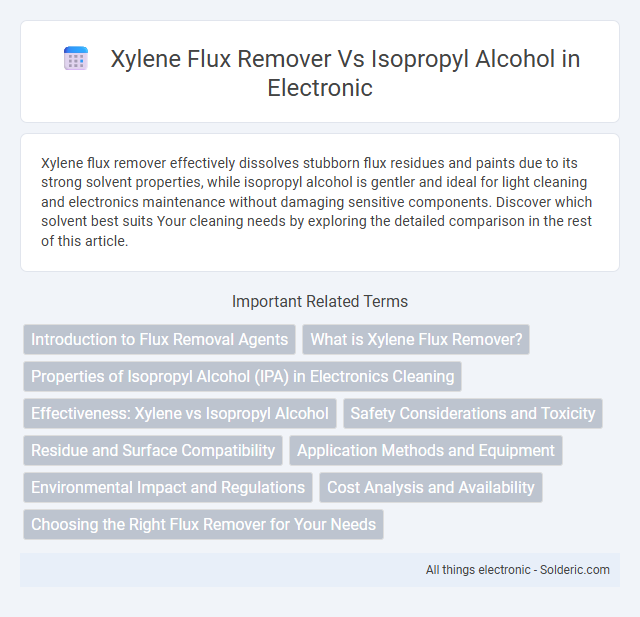Xylene flux remover effectively dissolves stubborn flux residues and paints due to its strong solvent properties, while isopropyl alcohol is gentler and ideal for light cleaning and electronics maintenance without damaging sensitive components. Discover which solvent best suits Your cleaning needs by exploring the detailed comparison in the rest of this article.
Comparison Table
| Feature | Xylene Flux Remover | Isopropyl Alcohol |
|---|---|---|
| Chemical Composition | Aromatic hydrocarbon solvent (C8H10) | Isopropanol (C3H8O), alcohol-based solvent |
| Primary Use | Removing flux residues in electronics soldering | Cleaning electronic components, general-purpose solvent |
| Evaporation Rate | Slow to moderate | Fast |
| Toxicity | Moderate to high; hazardous if inhaled or ingested | Low to moderate; safer for general use |
| Flammability | Highly flammable | Highly flammable |
| Effectiveness on Flux Types | Effective on heavy, resinous flux residues | Effective on light to medium flux residues |
| Residue After Cleaning | May leave oily residue | Leaves minimal residue |
| Environmental Impact | Higher VOC emissions; environmental hazard | Lower VOC emissions; more eco-friendly |
| Cost | Generally more expensive | Usually less expensive |
Introduction to Flux Removal Agents
Xylene and isopropyl alcohol are widely used flux removal agents in electronics manufacturing and repair, each offering distinct chemical properties for cleaning solder residues. Xylene excels at dissolving rosin-based fluxes due to its strong solvent action and low evaporation rate, making it ideal for heavy-duty flux removal on circuit boards. Isopropyl alcohol, with its rapid evaporation and lower toxicity, is preferred for light to moderate flux residue cleaning and general surface preparation.
What is Xylene Flux Remover?
Xylene flux remover is a specialized solvent designed to clean and dissolve flux residues left on printed circuit boards after soldering, ensuring optimal electrical performance and preventing corrosion. It is more effective than isopropyl alcohol for breaking down stubborn rosin-based fluxes due to its stronger chemical properties and lower evaporation rate. Xylene-based removers must be used with proper ventilation and protective gear as they can be toxic and flammable compared to the milder, more commonly used isopropyl alcohol.
Properties of Isopropyl Alcohol (IPA) in Electronics Cleaning
Isopropyl alcohol (IPA) is a preferred solvent in electronics cleaning due to its fast evaporation rate and excellent ability to dissolve oils, flux residues, and contaminants without leaving residues. Its low toxicity and non-corrosive nature make it safe for delicate circuit boards and sensitive components while effectively reducing the risk of corrosion or damage. You benefit from IPA's strong sanitizing properties and quick drying time, ensuring cleaner electronic devices and improved performance.
Effectiveness: Xylene vs Isopropyl Alcohol
Xylene flux remover outperforms isopropyl alcohol in dissolving and removing stubborn flux residues due to its stronger solvent properties, making it highly effective for heavy-duty cleaning on electronic components. Isopropyl alcohol is less aggressive, offering safer use and quicker evaporation but may require multiple applications for thorough flux removal. Your choice depends on balancing cleaning strength with material safety and drying time for optimal results.
Safety Considerations and Toxicity
Xylene flux remover poses higher toxicity risks due to its volatile organic compounds, which can cause respiratory irritation and central nervous system effects, making proper ventilation and protective gear essential when handling. Isopropyl alcohol is generally safer, with lower toxicity and less severe health effects, but it is still flammable and can cause skin dryness or irritation upon prolonged exposure. You should always prioritize safety by using both substances in well-ventilated areas and wearing appropriate personal protective equipment.
Residue and Surface Compatibility
Xylene flux remover leaves minimal residue, making it highly effective for cleaning stubborn flux without compromising sensitive surfaces. Isopropyl alcohol evaporates quickly and generally leaves no residue, but it may be less effective on heavy or resinous flux residues. Surface compatibility favors isopropyl alcohol for plastics and delicate components, whereas xylene is better suited for metal surfaces due to its stronger solvent properties.
Application Methods and Equipment
Xylene flux remover is typically applied using brush or spray methods, often requiring protective gloves and adequate ventilation due to its strong chemical properties. Isopropyl alcohol is commonly used with swabs, wipes, or spray bottles, making it suitable for delicate surfaces and quick evaporation without residue. Equipment for xylene removal often includes tanks or ultrasonic cleaners for thorough degreasing, while isopropyl alcohol is favored for handheld cleaning tools and precision electronics maintenance.
Environmental Impact and Regulations
Xylene flux remover is classified as a volatile organic compound (VOC) with significant environmental concerns, including air pollution and toxicity to aquatic life, leading to strict regulatory controls and disposal requirements under EPA and OSHA standards. Isopropyl alcohol, while also flammable and regulated, generally poses a lower environmental risk due to its faster biodegradability and lower toxicity in comparison, resulting in fewer restrictions for use and disposal. Regulations for both substances emphasize proper ventilation, personal protective equipment, and waste management to mitigate environmental and health hazards.
Cost Analysis and Availability
Xylene flux remover typically costs more than isopropyl alcohol due to its specialized formulation designed for effective solder flux removal in electronics manufacturing. Isopropyl alcohol is widely available at lower prices, making it a cost-effective option for general cleaning and degreasing tasks. Availability of isopropyl alcohol is higher across various retail and industrial suppliers, whereas xylene flux remover may require sourcing from specialized distributors.
Choosing the Right Flux Remover for Your Needs
Choosing the right flux remover hinges on the type of residue and surface compatibility; xylene flux remover excels at dissolving stubborn, resinous fluxes due to its strong solvent properties, making it ideal for heavy-duty cleaning tasks. Isopropyl alcohol, with its lower toxicity and fast evaporation rate, offers effective removal of light to medium flux residues, suitable for sensitive electronics and delicate components. Prioritize xylene for industrial-grade cleaning where aggressive solvent action is needed, while isopropyl alcohol serves well for routine maintenance and environmentally-conscious applications.
xylene flux remover vs isopropyl alcohol Infographic

 solderic.com
solderic.com